5.2 What are the pressures and state of hazardous substances in Northland?
Similarly to the solid waste management chapter, this chapter on waste hazardous substances differs from other chapters in this SOE Report, in that waste hazardous substances and contaminated sites are not an environment but potential pressures on our environment. Therefore it is clearer to present the pressures and state of waste hazardous substances together in this section.
Users of waste hazardous substances
Based on the HAIL list (MFE 2004) there are approximately 40 different industries in the region that used hazardous substances on a regular basis as part of their processes, including more than 500 sites. The industry types ranged from petrochemical plants, timber preservation sites and food processing industries to small manufacturing businesses and single-person contractors.
The options available within New Zealand for the disposal of waste hazardous substances are now limited to the lower key substances such as hydrocarbon-based products and some of the less innocuous herbicides and pesticides. The balance of waste hazardous substances now has to be sent overseas for destruction by high-temperature incineration. Council staff members regularly receive enquiries from businesses looking for disposal options for a wide range of hazardous substances.
Environmental incidents
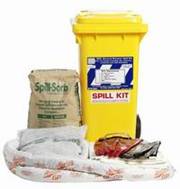 Between January 1994 and December 2006 a total of 1026 incidents involving hazardous substances have been reported to the Regional Council. (This does not include all hazardous substances incidents dealt with under the Department of Labour contract, which are discussed further in Case study 1).
Between January 1994 and December 2006 a total of 1026 incidents involving hazardous substances have been reported to the Regional Council. (This does not include all hazardous substances incidents dealt with under the Department of Labour contract, which are discussed further in Case study 1).
The majority (91% or 938) of these incidents were oil, diesel or other fuel spills, of which 61% (569) were marine spills.
Right: Kit available at service stations for fuel spills
The number of incidents involving hazardous substances, including oil spills peaked in 2000 with a total of 127 incidents as shown in figure 1 (below).
In recent years the number of marine oil spills has decreased, due to a public education and awareness programme run by the Council. On the other hand, the number of incidents involving hazardous substances, excluding oil spills, has increased slightly. This is likely to be a result of increased public awareness. The incidents involving hazardous substances range from chemical fires and chemical spills to incidents involving asbestos or dumpings of unknown substances.
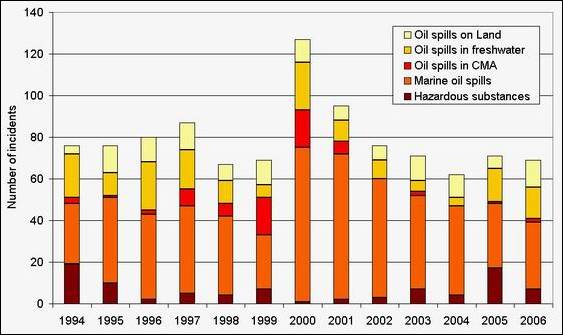
Figure 1: Incidents involving hazardous substances reported to the Council from January 1994 to December 2006, including all oil, diesel and other fuel spills.
Waste hazardous substances collected
From June 1993 to June 2007 over 64 tonnes of waste hazardous substances have been collected from throughout Northland and disposed of or recycled. The amounts collected each year are shown in figure 2 (below). There was a large amount collected in the 2004/2005 year, due to the mobile waste hazardous substances rural collection service run by the Regional Council. In the last two years the amount of waste hazardous substances collected each year has decreased.
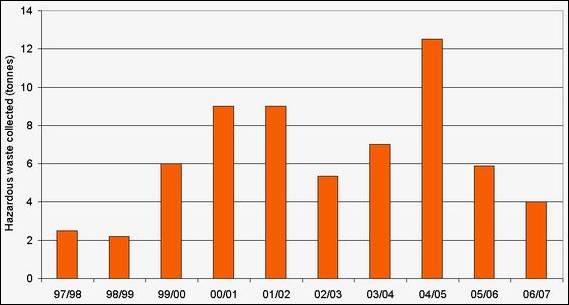
Figure 2: Approximate total waste hazardous substances (tonnes) collected each financial year in Northland for redistribution, storage and disposal.
Each year there has been between five and 15 tonnes of waste hazardous substances collected for long-term storage, redistribution, pre-treatment and/or disposal. Examples of the types of substances collected and their disposal are summarised below.
Insecticides and fungicides
Approximately one to three tonnes of insecticides and fungicides have been collected every year. Over the last five years the majority of these products have originated from the Kerikeri area. Approximately 90% of the total volume of insecticides and fungicides collected are destroyed, due to the deteriorating condition of the contents, illegible labels or unidentifiable contents.
Persistent organic pollutants
Every year a small percentage of the hazardous wastes collected have been persistent organic pollutants (POPs). Some of these POP substances handed in for destruction are particularly hazardous, including quantities of DDT, Chlordane, 245t, 24D dust and polychlorinated biphenyls (PCB's). All of these wastes are sent overseas for destruction by high-temperature incineration.
Solvents and laboratory chemicals
Every year approximately one tonne of used solvents and laboratory chemicals have been collected from schools, commercial laboratories and commercial entities. In the case of the solvents the majority are reconstituted and recycled, while the laboratory chemicals are all disposed of through an Auckland-based specialist waste management company.
Herbicides
Every year approximately three tonnes of herbicides have been collected from throughout the region, predominately from the four jointly owned and operated Northland Regional Council PGG Wrightson stores at Kaitaia, Waipapa, Dargaville and Whangarei.
Approximately 50% of the herbicides collected are still readily available on the market and legal to use. These are redistributed to Landcare groups and other voluntary organisations for vegetation and weed control. The remainder are in a deteriorating condition and exported for destruction.
Empty containers
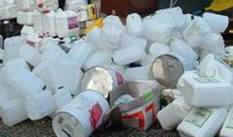 Every year there has been approximately one to two tonnes of empty containers collected from throughout the region. These containers are not counted in the total of hazardous substances collected in figure 2 (above). All containers are triple rinsed with the rinsate collected and disposed of through a specialist Auckland-based waste management company. The majority of the containers are shredded and disposed of by the contractor.
Every year there has been approximately one to two tonnes of empty containers collected from throughout the region. These containers are not counted in the total of hazardous substances collected in figure 2 (above). All containers are triple rinsed with the rinsate collected and disposed of through a specialist Auckland-based waste management company. The majority of the containers are shredded and disposed of by the contractor.
Farmers and growers will have access to a sustainable environmentally preferred disposal alternative to landfilling or burning their containers when the Agrecovery plastic container stewardship programme starts in 2007 (more information below).
Storage and disposal of hazardous substances
The safe disposal of redundant or unused agricultural chemicals and other waste hazardous substances is an issue for all communities, especially given the very few disposal options available in this country. There are currently only two commercial hazardous waste disposal facilities available in the top half of the North Island. While some NZ landfills offer co-disposal for low risk hazardous wastes, this option is not available in Northland.
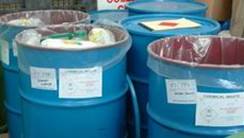 Some of the more hazardous agricultural chemicals held by farmers and horticulturists (especially persistent organic pollutants such as DDT, Dieldrin, Chlordane and 245t) cannot be legally disposed of in New Zealand. These substances require special disposal technologies such as high-temperature incineration. As New Zealand produces a relatively small volume of waste hazardous substances by world standards, it appears highly unlikely that any New Zealand-based technology will become available in the short term or indeed long term.
Some of the more hazardous agricultural chemicals held by farmers and horticulturists (especially persistent organic pollutants such as DDT, Dieldrin, Chlordane and 245t) cannot be legally disposed of in New Zealand. These substances require special disposal technologies such as high-temperature incineration. As New Zealand produces a relatively small volume of waste hazardous substances by world standards, it appears highly unlikely that any New Zealand-based technology will become available in the short term or indeed long term.
Under the Basel Convention of which New Zealand is a signatory, hazardous substances can be shipped to other countries for disposal, such as Canada, Europe or the United States. A company based in Auckland currently holds licences for the export and destruction of hazardous substances.
The majority of waste hazardous substances have been sent overseas for destruction (arranged through the Ministry for the Environment). There is presently a small remaining volume of hazardous substances that are packed in United Nations approved containers and stored in licensed premises in Auckland. The Council regularly inspects the integrity of the containers and their contents until they are sent overseas for destruction.
Contaminated sites
It is estimated that there are currently more than 1000 contaminated sites in Northland. These sites are currently being reviewed and a new contaminated sites database designed for accurate data storage.
Site investigations and remediation
There have been many contaminated sites in Northland investigated over the last five years. If the investigative sampling showed contamination then site remediation was carried out. Some of these sites are detailed below:
Service stations
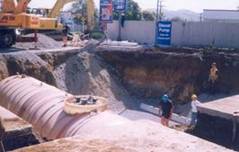 Over the past four years the four oil companies have continued their programme of replacing underground storage tanks at service stations. The programme has been driven by two factors: The length of time that tanks have been in the ground and product loss from the tanks.
Over the past four years the four oil companies have continued their programme of replacing underground storage tanks at service stations. The programme has been driven by two factors: The length of time that tanks have been in the ground and product loss from the tanks.
In Northland a total of approximately 120 underground storage tanks have been removed, each site remediated if required, and the tanks replaced or the service station closed down.
Oil storage sites
During the past few years two major bulk petroleum storage sites adjacent to the Port Whangarei industrial area have been demolished and remediated to industrial land use standards. In addition a smaller site in Kaikohe used for the bulk storage of petroleum-based products has also been demolished and the site remediated to industrial land use standards.
Timber treatment sites
Three timber treatment sites at Mangawhai, Kaitaia and Haruru Falls have been investigated by the Council. At Haruru Falls and Kaitaia extensive remediation works have been undertaken. At the Mangawhai site the contamination levels encountered met the industrial standards for contaminated sites (MFE 1997) and were much lower than at the Haruru Falls and Kaitaia sites. For more information check out Case study 2.
There has also been two timber treatment sites at Tinopai and Dargaville investigated and successfully remediated by Carter Holt Harvey. The entire process was overseen by the Regional Council. The Regional Council also carried out a site investigation of the Benchmark timber treatment site at Waipapa. Benchmark carried out extensive remediation and the Council showed that the site was successfully remediated with validation sampling.
Animal Dip Sites
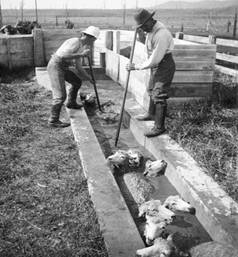 Four former animal dip sites located at Mimiwhangata, Kaeo, Mamaranui and Kerikeri have been investigated for contamination.
Four former animal dip sites located at Mimiwhangata, Kaeo, Mamaranui and Kerikeri have been investigated for contamination.
The only site requiring remediation was the public animal dip site at Kaeo that was formerly owned and operated by the Mangonui County Council. The land where this dip was sited is now in public ownership.
Right: Sheep dipping in New Zealand, around 1924, courtesy of Adkins Collection, Alexander Turnbull Library.
